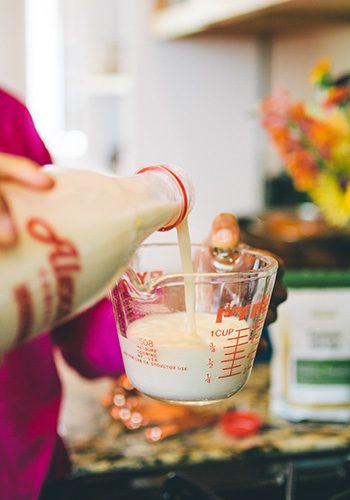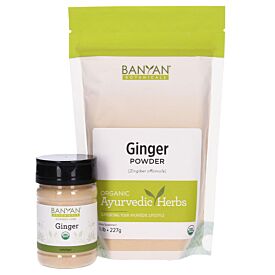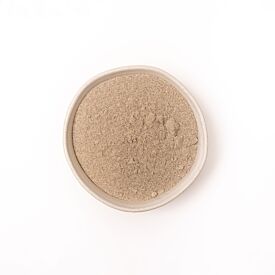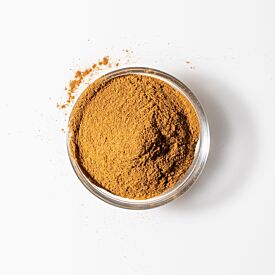The Ayurvedic Perspective on Milk
In India, cows are considered sacred and their milk is revered as a precious gift that comes straight from the Goddess.1 Since ancient times, Ayurveda has highly valued milk for its building and tonifying qualities and its ability to strengthen ojas, our vital immunity.
Yet when it comes to the gifts of the goddess, some of us take in her nourishment more readily through mantras and kirtan than from cow dairy. And while there is much to be revered about this creamy white nectar of the gods, the Ayurvedic perspective on milk is more nuanced than you might suspect.
When it comes to milk and dairy products, it’s helpful to keep the context of Ayurveda’s origins in mind. This nature-based system of healing developed in ancient India, long before the advent of synthetic hormones, factory farms, food manufacturing facilities, or agribusiness.
While milk and dairy products are common, they are often not of the same quality enjoyed centuries ago. Yet, like so much of the wisdom and tools of Ayurveda that have withstood the test of time, the benefits of high-quality, organic milk still have much to offer.
The fresher the milk, the more prana or life force it can offer us.
I know one Ayurvedic physician who regularly makes her way to a local dairy farm for the freshest, purest milk and goes straight home to make her ghee and swiftly boiled milk. For those of us who can do this, or raise animals with respect, be they cows, goats, sheep, water buffalo, or others, I rejoice!
But for most of us, this direct relationship with dairy fresh from the farm is not always possible. So, what can we do, within the boundaries of our ethics, resources, and the planet at large? Here is some information on milk and milk alternatives from an Ayurvedic perspective. I leave it to you to respond appropriately for yourself.
Environmental Impacts and Considerations
Inherent in the philosophy of Ayurveda is a commitment to live in harmony with nature, which leads to a sense of respect for food, the earth, and its inhabitants—including humans, animals, and plants.
And while this thread of respect for the earth has survived and resurfaced in the awareness of many people today, as a species we have strayed far from it over time and environmental responsibility is still lacking on many fronts.
Because of the modern agribusiness practices that affect dairy and so many other foods today, it’s important to keep in mind where your milk is coming from and what environmental impacts it may have. If you can find dairy that is fresh and local, it will likely be the best choice for both your body and the planet.
In terms of carbon footprints, plant-based milks generally have less impact than animal dairy. In fact, rice, almond, and soymilk have one-third the climate impact of cow milk.2 Goat milk here in the US has a modest carbon footprint, with fewer goats than cows, but this is not true worldwide. Sadly, goats exceed cows on the planetary emission level.3
Lest you race out immediately to purchase that virtuous almond milk, I invite you to consider another factor: plastic containers. Ruth Ozeki wrote compellingly about the “Great Pacific Garbage Patch” of plastic bags in her novel, A Tale for the Time Being. Unfortunately, many fine products are robed in plastic these days.

Nutritional Benefits of Dairy
Dairy is a rich source of proteins and minerals that are essential to the health of the human body, helping build and maintain healthy bones, teeth, nerve function, and muscle contraction.
A cup of goat’s milk offers 327 milligrams of calcium, 271 milligrams of phosphorus, a whopping 498 milligrams of alkalizing potassium, and close to 9 grams of protein.4
Cow’s milk offers very similar nutritional benefits, and sheep’s milk is even richer in calcium and protein.5 Growing children and pregnant women need these minerals and proteins the most.
If mineral balances are askew, physiologic functions can falter. This is especially common with calcium and phosphorus in the predominant American diet. While Americans get more calcium-rich foods than much of the planet, we have high rates of osteoporosis. Why? One factor could be our relative intake of calcium to phosphorus.
Rather than a healthy 1:1 ratio of calcium to phosphorus, we range toward 1:4, taking in four times more phosphorus than calcium, mostly through meat and sodas. This unbalanced ratio of minerals does not support healthy bones and teeth.6
While animal dairy is a great source of balanced minerals, it’s also possible to get calcium, magnesium, phosphorus, and protein from wholesome plant-based milks, with attention and wise choices.
The Importance of Preparation
How one prepares milk has a lot to do with how well the body can receive and absorb its benefits. Traditionally, milk came directly from the mother animal and was not pasteurized or genetically modified. It was then heated to just below boiling and consumed warm.
Animal dairy’s mucus-forming and kapha-increasing qualities are likely to be more pronounced if milk is served cold, frozen, dried into powder, otherwise processed, or served without spices. In these latter cases, dairy can be congesting, constipating, and ama-producing.
Adding spices to milk also counters its cool qualities and balances its heaviness. Ginger, cinnamon, and cardamom enhance its digestibility substantially and reduce mucus production.
Another thing to consider from an Ayurvedic perspective is the importance of proper food combining. While milk gets along well with many foods, we often combine foods that Ayurveda considers incompatible with it, such as sour fruits, bananas, cherries, melons, yeasted breads, yogurt, kitchari, fish, and meat. Eating these foods at different times than milk will help with the body’s ability to digest them well.
The Qualities of Milk and the Effects on the Doshas
Dairy is food produced from the milk of mammals. In looking at any food, Ayurvedic nutrition takes into account its qualities (gunas), such as cold and hot, its unique balance of the six tastes, and its energetic impact on the doshas.
Each food is unique and has a different impact on the doshas, the three biological energies of vata, pitta, and kapha. Each person is also unique and receives nourishment in differing ways. Thankfully there are a variety of both animal and plant-based milks, and what may not work for one person could be perfect for another.
Cow Milk
Cow’s milk is cool, heavy, laxative, and mucus-forming. It has a sweet taste (rasa), a cooling effect on the gut (virya), and a sweet, building long-term effect (vipaka). If you warm it up and spice it appropriately, cow’s milk is highly regarded in Ayurveda for calming both vata and pitta. Its cool heaviness can aggravate already cool kapha.
Goat Milk
The rasa, virya, and vipaka for goat’s milk is sweet, cooling, and pungent. Like cow dairy, it is nourishing and strengthening, but tends to be lighter and less mucus-forming. According to Vasant Lad, MASc, it is tridoshic (balancing for all three doshas) and a preferable milk in moderation for kapha. Goat milk is slightly astringent, which for some can rile vata.
Sheep Milk
Sheep’s milk is more heating than cow or goat milk. It calms vata, but aggravates pitta and kapha.7
Buffalo Milk
Buffalo milk was recommended by the sages for its ability to induce sleep. Colder and heavier than cow’s milk, it soothes pitta and vata, but increases kapha. It is used to slow rapid elimination. Buffalo milk is available in India and Italy, yet here in the United States, it is rare to find.8
What about Plant-Based Milks?
Taking into account both environmental and physiological considerations, plant-based milks offer a viable alternative for those who wish to avoid animal dairy. If we can make our own plant milk, it means less plastic in the ocean and provides a direct benefit to our body’s energy.
Almond milk in particular builds ojas, strength, and immunity in the same way that warm, well-spiced cow’s milk does. It calms vata and pitta and can be used occasionally by kapha.
Plant-based milks offer healthy fat, relaxing magnesium, and small amounts of fiber, yet a lot of them have appalling amounts of cane sugar. Sugar impairs immunity, and at this point, we need as strong an immune response as possible. Many plant milks also contain various gums, like carrageenan, which can aggravate some digestive tracts.
If you prefer a plant-based milk option, be sure to look for plain, unsweetened, and organic varieties. There are several fine companies offering tasty milks with just a few simple ingredients—organic nuts, water, and a pinch of salt.
If you want to add a little sweetness, you can use raw honey, stevia, or coconut sugar. Honey in particular carries the nourishment of milk deep into the tissues.
When you’re trying out different plant-based milks, you can ask yourself, is this calming, tonifying, and building for me? From an Ayurvedic perspective, these are milk’s most important purposes.
Nut and Seed-Based Milks
Sunflower, pumpkin, and hemp seed milks are well-tolerated by all doshas. Warm, heavy sesame seed milk is better for vata than pitta or kapha. It is a rich source of calcium, with 312 milligrams per two tablespoons of milk.9
Nut milks are a little heavier and oiler, fine for vata but best used in moderation by pitta and kapha. Coconut milk is the exception to this rule, as it is cooling enough for pitta while also nourishing and pacifying for vata. Because of its cooling and heavy qualities, it is not the best choice for kapha.
Consider making raw, homemade pumpkin (or sunflower) seed milk. Both of these seeds are affordable and rich in zinc, a trace mineral that supports immunity and healthy blood sugar metabolism. If you can find raw hemp seeds, they also make a tasty, high-protein plant milk that is rich in healthy omega-3 fatty acids.
Grain Milks
To assess a plant-milk’s impact on the doshas, consider its ingredients, as well as how your body responds to it. Sweet-cooling-sweet oat milk is a popular choice, calming to vata and pitta, yet increasing to kapha. If you follow a gluten-free diet, shop carefully with oat milks, as most are not gluten-free.10
Rice milk is also sweet-cool-sweet in nature and best for vata and pitta constitutions. Watch out for the added sweeteners in rice milk and try to avoid them when possible.
Organic Soymilk
Organic certification is especially important in soy milks. Soy is a legume that’s been widely genetically modified in the United States, but GMOs are prohibited in every step of organic farming. Organic soy milk is sweet and astringent, with a cooling virya and a pungent after-effect. It is best for pitta, and aggravates both vata and kapha.
Relax and Enjoy
Personally, I’m milkvorious. Last night my husband Gord and I taste-tested hot, spiced macadamia milk in our favorite creamy carob hot drink before bedtime. This plant “creamer” gave us 100 milligrams of calcium per cup, along with all the other herbal benefits of the recipe. And I’ve got to say, it was delicious and we slept like stones.
Now that you’re equipped with the Ayurvedic perspective, you can more easily choose which type of milk will best support you. Here’s hoping you find the drink that brings the most happiness and nourishment to your body, mind, and spirit—and have fun experimenting in the meantime!









